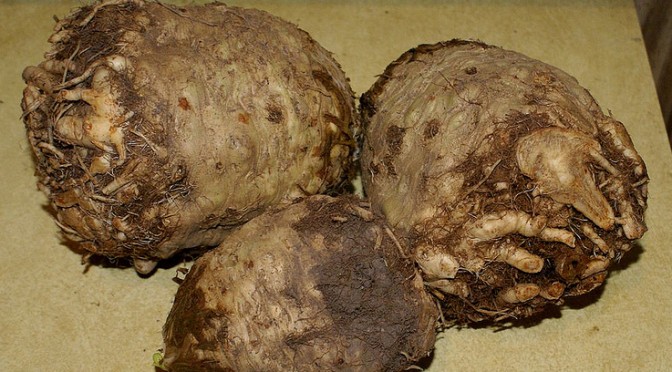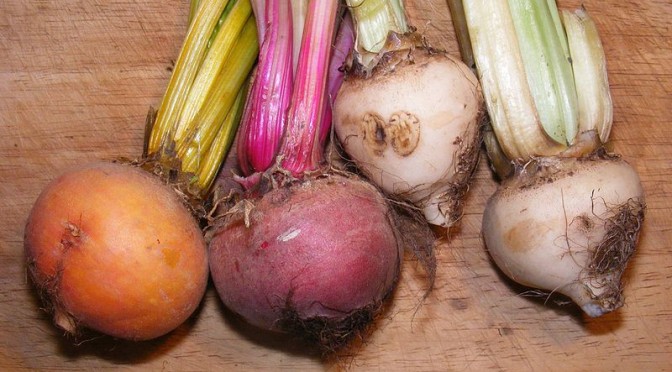I only discovered celery root in the past few years and it truly is a wonderful and under-appreciated vegetable. Yes, it looks weird and has an ugly-looking skin that harbors dirt when you get it. But it cleans up nicely and it is delicious in so many ways. It’s one of three vegetables that people frequently ask me about when I check out at the grocery. The other two are Daikon radish and kohlrabi, both of which I’ll cover in this series. These vegetables seriously need a publicist!
Once again, this is an old world vegetable that dates back to the classic times. It was called selinon when it was mentioned in Homer’s “Odyssey”. Also known as celery root, knob celery and turnip root celery, this knarly-looking vegetable originated from wild celery. Unlike the usual celery with its trim green stalks, celery roots grow thicker stalks with lush green leaves and a large bulb root below the ground. The entire vegetable, excepting the string roots off the bulb, is edible, although the stalks tend to be a little tuff. When I’m fortunate enough to find a celery root bulb with the greens still attached at the grocery store, I buy it. The leaves are easily dried in a food drier or out on a sheet of waxed paper in a sunny place for a few hours.
Describing a flavor isn’t always easy, but the root portion has a mild celery flavor with a bit of nuttiness — it’s amazing how many food are described as having a nutty flavor. It is crisp when freshly cut and can be used raw in salads. But when it’s cooked, it becomes creamy and it is the closest vegetable in texture that I’ve found to the potato. I often use it as a potato substitute, particularly when making French fries. It’s great in soups, stews, stir fry dishes and other places where you would use potatoes. It can be roasted and baked.
The leaves and stalks also have a celery taste, but the stalks I’ve encountered tend to be woodier than normal celery. The leaves are nice for garnishes or adding to soups and stews or in with cooked greens. Dried, they can be added to many dishes whenever you want to add a hint of celery to flavor.
Cleaning and Preparing
I admit it’s a bit of a challenge to clean and trim the celery root. Use warm running water and a scrub brush to clean up the skin as much as possible. There are many little cracks in the root’s surface where dirt can hide. Once clean, dry it off, then cut the knobs off with a chef’s knife or a sharp paring knife.
Peel the outer skin off and dig in where the exterior skin may have made a crevice in the vegetable. It’s like a potato eye, just take the paring knife and cut in under it to remove. Then cut the root into cubes or planks, depending on how you want to use it. The bigger roots can be difficult to cut through and it may take a lot of muscle to get the knife through the whole root.
Once you’ve trimmed the root, parboil it in a pan of boiling water with a splash of lemon juice for about 3 minutes. This will help prevent browning. If you aren’t going to use the cubes or planks right away, then put in freezer bags, press out as much air as possible, label with the date and put in the freezer. If you’re using it soon, just put in a plastic bag until ready to use.

If you want to bake the celery root, you can just clean the exterior as much as possible, poke with knife a few times, rub a little oil and seasoning on it, then put in the oven at 375 degrees (F.) to bake for about 45 minutes to an hour. This will vary with the size of the celery root. Once done, peel off the outside skin and serve the creamy insides like you would a baked potato. It’s great with butter, sour cream and bacon bits.

Nutrition Info for 1 cup Celery root
Calories: 66 Fat: 0.5 Net Carbs: 11.9 g Protein: 2.3 g
Recipes
I use celery root frequently as a replacement for potatoes and just as a delicious vegetable on its own. Here are a couple of recipes from this site that use celery root.
Quick Roasted Celery Root (mid-way down the page)
Warming Beef Stew for Fall
Corned Beef Hash
Celery Root Fries (near the bottom of the page)
My references for this article include the following web sites: Wikipedia, Eat the Seasons and The Vegetable World’s Ugly Duckling


